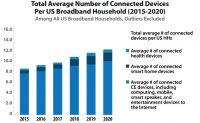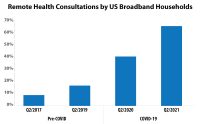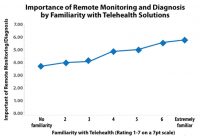From Facility to Home: COVID-19 and New Connected Health Use Cases

Consumers own more connected health devices on average than ever before. Research reveals that 30% of all U.S. broadband households own three or more connected health devices in 2021, up from just 16% the previous year. Additionally, the adoption of connected health devices—defined broadly—is growing year-over-year. Fifty-five percent of U.S. broadband households report owning at least one in a list of connected health devices as of Q2 2021, up from 24% when the research firm first surveyed this topic in 2013.
COVID-19 has created a wave of change—no matter where you sit in the ecosystem—provider, payer, vendor, consumer—with a new mindset emerging towards the home as a viable and valid location for health management and healthcare delivery, causing an increase in use cases for connected health at home.
Thinking about the surge in device adoption and the variety of data devices collect, several new possibilities for connected health use cases emerge. From the more established use case of remote-patient monitoring for chronic condition monitoring or monitoring after discharge from the hospital to diagnostic support for telehealth consultations. Advanced technology allows sensors and devices in the home to proactively monitor and support older loved ones as they age safely and well in their own homes. Directly brought on by COVID-19, a new use case has developed—proactively monitoring one’s health and one’s family members’ health for signs of illness to safely engage in public life, from travel, to education, to working on-site with colleagues and clients.
We’ve seen dramatic increases in telehealth usage this year. By April 2021, 64% of U.S. broadband households used a telehealth service within the 12 months prior, compared to just 15% in 2019. This includes all modalities, not just video visits, so this consists of the primary way telehealth occurs still today, which is simply by telephone.
 |
 |
 |
| All figures courtesy of Parks Associates. Click to enlarge. | ||
Of course, the instruments and data providers are privy to in a facility setting are not present in most virtual consultations today. So, many conditions or injuries or illnesses can’t be diagnosed or treated in the same way at home right now without provider (and even patient) access to the right equipment and the necessary data.
However, consumers see the value of incorporating health devices or sensor data into a virtual care scenario. Fifty-two percent of consumers in U.S. broadband households find a telehealth service that allows them to share data from medical devices in their home during that telehealth visit to be appealing—up from 46% in 2019. And this rises, of course, among those who do already own connected health devices.
We also tested the appeal of various approaches to using smart products to help seniors live well and independently:
- A panic button, a traditional PERS style device—with fall detection capability
- A smartwatch that detects falls, has a panic button and also detects location and some vital signs
- A home sensor-based system with passive monitoring, with no devices that need to be worn
- A smart speaker or display system
All of the approaches tested well, with about half of caregivers stating an intention to purchase each solution for their loved one, if it had their desired features. Of the solutions tested, a panic button is a known solution to an immediate problem. Many PERS providers are no longer staying in this bucket, expanding beyond the basic PERS offering into the smartwatch category, counting steps for the more positive focus on proactive wellness, incorporating passive sensors for activity monitoring or fall detection, and adding voice control has another way to call for help. Smart watchmakers, in the meantime, have added cardiac tracking, fall detection, blood oxygen readings, and even blood pressure detection.
Innovation in virtual care solutions is facilitating easier healthcare access to consumers beyond the facility. As the focal point of care moves away from the care facility and into the home, there is anticipation that care providers and health systems will lean more heavily on connected health devices in advancing and expanding the future of healthcare.